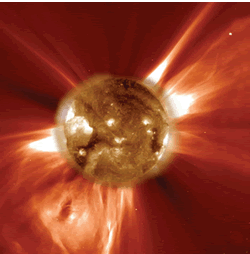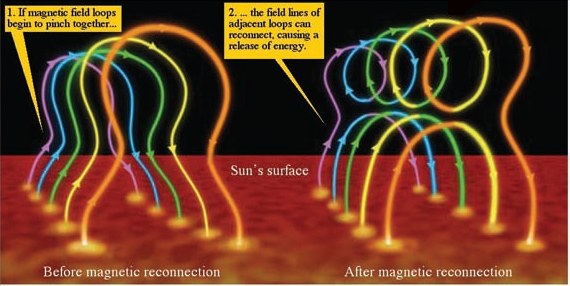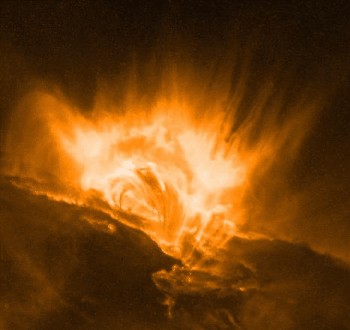Chapter 16. Solar Magnetic Fields
16.1 Introduction

Author: Scott Miller, Penn State University
Editor: Grace L. Deming, University of Maryland

The goals of this module:
- Describe how convection and differential rotation affect the solar magnetic field.
- Explain how the different types of solar surface activity are magnetically driven.
In this module you will explore:
- How magnetic fields fuel violent reactions on the solar surface.
- How different types of solar surface activity are simply different manifestations of the same phenomenon.
Why you are doing it: The opaque 'surface' of the Sun, called the photosphere is home to some of the most fascinating and explosive phenomena in the solar system. Solar surface activity is responsible for spewing out energy and material, which impacts our atmosphere and thus directly affects life on Earth. Understanding how the Sun's magnetic field drives this surface activity is the key to understanding the phenomenon itself.
16.2 Background
The Sun is not a solid body, and therefore it does not rotate like a solid body (such as the Earth). On Earth, the rotation rate is the same regardless of where you live; this is why a day is 24 hours long in China, Antarctica, Ecuador - everywhere! But this is not true on the Sun or any other gaseous body. Different latitudes on the Sun rotate at different rates, with the equator rotating the fastest and the poles rotating the slowest. If the Earth rotated the way the Sun does, then people living in Norway or New Zealand would have a longer day than people living in the Caribbean.
Differential rotation is possible in a gaseous or liquid body, because material in these states has very low viscosity. This means that the particles of gases and liquids can flow past each other easily, with little shear. You experience this when you pour yourself a drink of water: the water flows easily into the glass. Solids, on the other hand, have high viscosity - imagine trying to "pour" a solid rock!
Scientists have measured the differential rotation of the Sun using sunspots. By tracking the rotation rates of sunspots at different latitudes, they have confirmed that the poles rotate slower than the equator.
Watch the video of the Sun over a two week period. Look carefully to see if you can notice a slight lag in the rotation of sunspots not located on the solar equator.

Question 16.1
SoNGTQ+6iMmMe6W2IgpxnmcN3kwFOs0gUbQQyZ0zK7xmG+Hnrs7jB7+u8zu86AFc5N+GOu+qUidUFEQYxi/uU0UkPfd2HgF0theKSBpSChUxWIVR9zZ8mIAafXHfLjySb4rP0DGwsYiobmJry96sLZvnc2+cq3dAmq7fYKd1ZcB3RAL7MVYwwEbdFVSWofEoaxftH10ehjKG6kf+PVK3ahuLpLA=Summary
Differential rotation is linked to many solar features and activity on the Sun, in part because of its effect on the solar magnetic field.The Sun's magnetic field is tied to the solar material and therefore rotates differentially just as the material does.
16.3 Magnetic Reconnection

Let's examine how this process takes place. You are probably familiar with a bar magnet, and you know that it has a north and a south pole. The solar magnetic field can be thought of as a giant bar magnet deep inside the Sun. Just like a real bar magnetic, it has a north pole and a south pole. When we illustrate the Sun's magnetic field, we draw straight lines along this imaginary bar magnet, with arrows pointing toward the south magnetic pole. Thus, a single field line is tied to material at both the solar poles and the equator. This means that the middle of the field line actually rotates faster than the ends, causing the magnetic field to become stretched and twisted around the solar equator. When they become too twisted, the magnetic field lines essentially break apart and reform straight lines, but with the poles reversed. It is as if the imaginary bar magnetic in the center of the Sun suddenly flipped over, reversing its orientation. This process is called magnetic reconnection, and it occurs roughly every 11 years in the Sun. What we have described thus far is half of a magnetic cycle; a complete solar magnetic cycle includes two reconnection events so that the magnetic field returns to its original orientation. The animation shows how this happens.
Question 16.2
uaSQfjwheZqDMSL8Crxcq3jYP04DcBJGEDbaJlGbgGm5G2t+uWGFXraR2BmdO3msr5hL7rmbMfm4OpvcltmhH9WAI+9GRrARrkvMn6dDaJavT7Kdjjvk+neIiz7JgUAozxYNhKTXAwDiK62ewFghr0+O1491PA2BRUohG0YBEXRGN7bPSooa29/muQpFADnwLidLjyvIFFNbxf31ZCpgAWPZk6VH8oC//OhPXXHYHZgcNMwjgCJ9fvX3otrdVNAlPQPf5QfFjbbHSoRljmoGHVzxAP13G5oTMAEpMOft6YUFU4mzm8Zu4IT6AwbAa6jZZnWk3sH1gzQMdXM7YQuIdOwlBCOAmWTrJL1YU9HCE8L8/ZSznN9PPVKRG/FwVe2PEC9u8P7aH6WM5IdmgT2YUqO6enUPW3Fyp+ZXp+Np8bzld7lq0fsgnVBkZCeK/AJy4uI2s6KaRRCtdJpD1lbkgefqwCiCQTLVu4A5fdfu0YGEMM9mgJnxgcVUQXqzGInUI8yUZ6uqYelkoPWXydh3/ANCPdmjdiIqNooi7vb66dU=16.4 Twisting The Sun's Magnetic Field - Differential Rotation
What happens to a magnetic field that gets all twisted up? Eventually, it reconnects as we saw in the previous animation. Before that happens, however, the field lines become compressed, which increases the strength of the magnetic field. Just as very hot gas rises, very strong magnetic fields become buoyant and rise above their surroundings. On the solar surface, regions of stronger than normal magnetic field can "pop" out of the photosphere, forming loops in the upper regions of the Sun's atmosphere.

When seen against the background of the Sun, we see only the bases of the magnetic field loops where the loops emerge out of the photosphere; these dark regions are called sunspots. If we use a filter that reveals the structure of the photosphere itself, then we can see the field loops stretched across the surface of the Sun; these are known as filaments. When viewed against the black backdrop of outer space, the magnetic field loops become easily visible and are called prominences.


Question 16.3
2qbRMCdLUM4B6UXwrJJ8rDCALusYNtlTwi0jKnRaN+lUD1vZkirA4WC8pey0VSIRrPBVvSwYCfMavSe6f5sSvoJpbcoFMKjMK5GW0D0uJiA1RAvISlkfpxkLj4ysBXq0tHrIqgf1u0DUu42lGTL0MaYaxMDTKXg8tgHE+DdidKAXb5r9h5Dr5RciTSagGawXaljl7GEM4DJ96JExygNNannuITnWiQlmAX0dBbGQEVsbw/mXo5OiRc58efIHKK41wW3LS8QxrvC4nAc3CjfD+lDtr7YKqtB6Lqo5wrBlxO9s6J1wbKq6sg9DPWhT0vj411aImPzpvOMxgLgPSNAhjx/eQLRHF4yot51K3QPd12bFuYUBnFSZ5SjvQt+GWyl7ZDEBSlryjLBZtAG/GW8LBdU1qTh1OU02R+MsDzKniILiuSIZ+Iys4Yw8ZTgdOiEv8Lt6xJRjm81VLWdInz0SbSReot7NWE0VhecKvIoVD+cgYzZ304FKZfZ3+ub8u2NZxB3LG5KitxbeQU2rifJt8lPQmj2Yk0MFCLCpuHNR8+8z36BRIWk5JlYdXZpZDH1manQMX+PwXEosHk+lzEMlXGD+IpAa0b5n/cT3syEKtGc5aot+iJeHQ1kwXivAI1JDIjKKb8sbnkrB7eXHAjf/zjj+Bd7M5evZGtVQH7Bfc05qTAc5kRVQlSVABAoSQ552aSHHzL9WS9VGcE+esbQfhyNaLKgtIQOZfHrCzIGzzIkDaW36iJ81/MmMS/rIMYTI5yWep+mnccqk2M2mR5eBhmfMPxyFjaEX16.5 Twisting The Sun's Magnetic Field - Convection
Differential rotation is not the only solar motion that affects our Sun's magnetic field; convection is also responsible for twisting it. The gas directly under the photosphere layer is boiling with the energy rising up from the nuclear furnace deep in the core of the Sun. The gas rises in tubes, then drops back down after it cools.
View the movie taken by the Dutch Open Telescope in 2003.

The circular motions in these convective cells twist and churn the magnetic field. These motions cause the bases of the field to move, which can lead to reconnection events where localized portions of the magnetic field break apart and then reform with a new configuration. These reconnection events do not lead to a large scale reordering of the magnetic field like that discussed in the beginning of this activity, but they can nevertheless release bursts of enormous amounts of energy. The figure below shows how convection can twist the bases of a magnetic field loop leading to a reconfiguration of the field with a tremendous release of energy.

The energy released during reconnection heats the chromosphere (the portion of the solar atmosphere above the photosphere) and corona. The TRACE satellite captured just such an event taking place.

Question 16.4
PNBcq4s1A4AEDiB5i7b1jhscrg/r1RqHFiBHXSCzZlD3tZETzE1ilMBiGgWcXcXhXU+lQQa6HKRAIE+qnIR55wADDVlx2ncMyO6OOWC4L5Z4hcZmLUR9IPR1iVoPtO79DZvEhgKKmwgLOrTz8cnUCqhdrU8pNJofIjiap5KT4w5Vpgj3tVw7Gj/kFhzL4nBhxMkAnNbGr4A9qAlrlgtyZYhXFQdRIvXquyPDBYscfi9YiQQwAMuiFr54khQY8dZpo7SLLwu8pb8cqLmE36V0XLouFEzQAQ7MaN7aEj0zfYiSe2i5f/ahkl/XCotGWxhCNQ+cSQlLBSmcXySgANtypcACxvoKIUoQRyXUjlbvjQSzSPpKU0jfbasozfTApyPpBD1aN4Yvdovcd54xEFSbiqSthrdxwB9HNTR+H/V+EFrtso2NqAvqqMJTJQfmw6qS91XeYxxJNUtqzz9xAGAFJ+0aT31Y6KVSE8O+2B+G746FD46RascQQuL2sVz+O2O9AtaqgkpwvPJ1x70wiReYFvZlSP+7MTRbfyl39wnqUlpLNM75Qso4Cw==16.6 Flares
When magnetic reconnection events occur in magnetic field loops, part of the loop can actually break free and fly out into space, carrying solar material with them. These events release enormous amounts of energy; they can even exceed (momentarily!) the amount of energy produced in the solar core via nuclear fusion. These reconnection events are called flares. Such events are associated with magnetic field loops connecting whole groups of sunspots.

Particularly huge explosions of gas, involving large portions of the solar magnetic field (instead of just small, isolate field loops) are called coronal mass ejections. The energy released in these massive reconnection events dwarfs that released by flares.

Question 16.5
p9hfHfSCliXF3+vFgQyOCvE4GdhWjC+0438mS8ywt6VfG1+w7+OdhFBD2Vb+c6tz0LmUoir1zHosrFU3tQ8KTgO++2PAn/fBq4jnE7gUfwMhd65qZZlQ8srsFSsqAQhDzhmmcqKIgIughZJ4uxdmoNrXxfOmeXVvpWlq3czmGrfnGbO5OGuOThECjIufyQ5FqSuT/FZt38KOZm970cipDgU/nhE+d7XlR2oSekk0ve3Nitwli7nco2ztePWpsNlOEbcqoeatPl7vM75phDeZTHI4cisRqOmMn+yaNGE2pL+AxADxC4QAqarRW9g5wujvrrB/Jd75ZCbbSl2xaLPO0K2/42+FzKkF8iFG9dFPFuQr6+F/PuKbLWOUtet4Ena2pFlkWvlJKNxG2Xn44xe5W2+PwV0QKi+IgYY6YIvJ/Fg9Nbxb3LC8C6xlrQredVvm7Jnq7bQH8KfXAdvbVr964uLcKlmH/GpFR3CsKZ4yEf8oK2j4lUMnq8LyVqCK8F6Si0ZdkrpIt/Zp6uhK6sVwzyqXA43dXtYQkygI9RSQ3HFGfh/9cHNWfJRfTkmcJ72WeuKYTSC3q8B3YwDJb6hfA6J17E0tL3L+ZyJeDZWN0rYVWj7+Ap8eVxIdyEO8E9Wv16.7 Quick Check Quiz
Indepth Activity: Solar Magnetic Fields